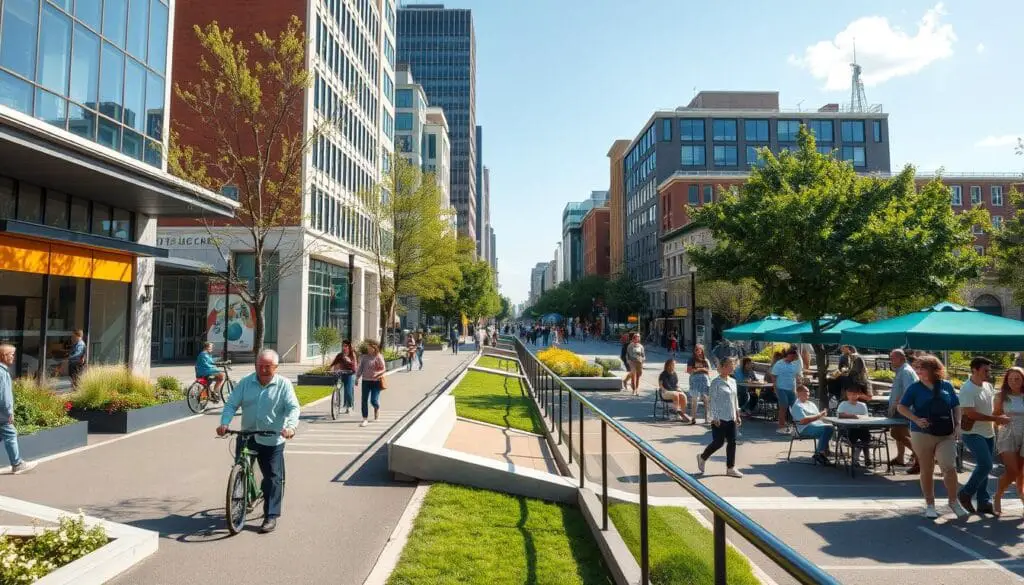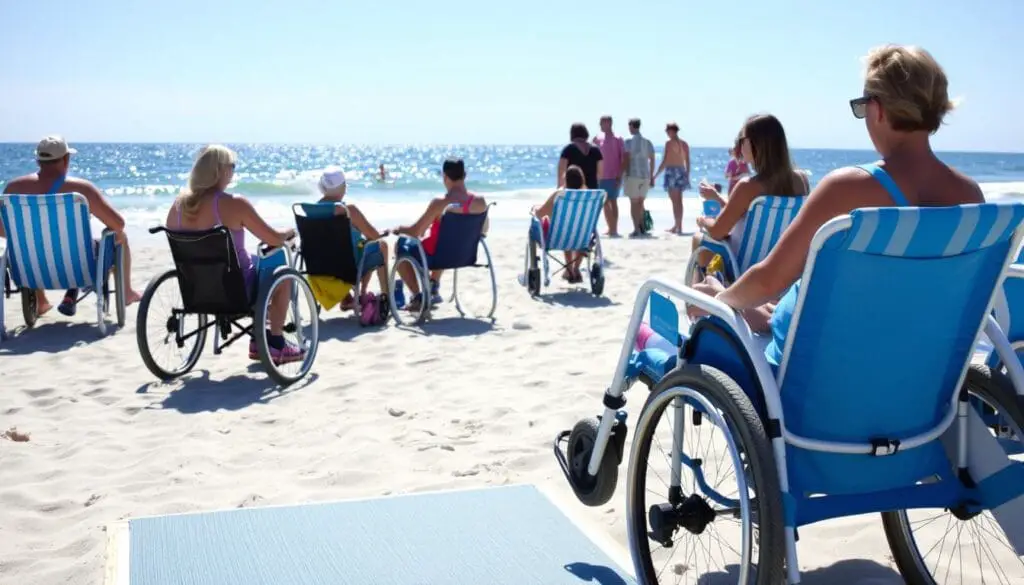Accessible Travel: 10 Powerful Tips and Destinations for Inclusive Adventures
This site contains affiliate links . At no additional cost to you, I may receive a commission off these links. They help fund this blog. Thanks for your support! See my Disclosure Policy for more info.
Traveling with a disability can be tough. But, with the right planning, it can also be amazing. Whether you’re in a new city or on a big adventure, the right steps can make your trip unforgettable.
This guide will show you how to travel easily. We’ll talk about the best places to visit and how to plan your trip. Accessibility means everyone can enjoy the world’s wonders, no matter their ability.
Table of Contents
Understanding Accessible Travel: A Modern Perspective
Accessible travel is now a big deal, aiming to make the world welcoming for everyone. Inclusive tourism ensures that all people, no matter their abilities, can enjoy travel fully.
The travel world is catching on to the need for accessible trips. 45% of European destination marketing organizations now focus on visitors with disabilities. It’s not just about physical access; it’s also about sensory needs and how we view disability.
Defining Inclusive Tourism
Inclusive tourism is more than just ramps and elevators. It’s about creating empathy, safety, and understanding. It’s about making travel experiences for everyone, so they can explore the world with confidence.
The Growing Need for Accessible Adventures
As more people age and disability rates rise, the need for barrier-free vacations grows. Travelers with disabilities want mobility-friendly destinations where they can fully enjoy cultural and outdoor activities.
Breaking Down Travel Barriers
Accessibility is more than just physical spaces. It’s a wide approach that meets all travelers’ needs. The industry is working hard to make travel inclusive, with sensory-friendly places and staff trained in disability etiquette.
Accessible travel goes beyond ramps and elevators. It’s about fostering empathy, safety, and cultural understanding.
Planning Your Inclusive Journey: Essential Preparations
Starting your journey with careful planning is key. Think about medical needs, guide dog rules, and what’s available at your destination. Look for places that offer wheelchair access, Braille, closed captions, and quiet areas for those with autism.
Make sure you have the right papers for your medical gear and drugs, especially when going abroad. Use maps, apps, and local groups to plan better. This helps find the best places to stay.
- Learn about airline, train, and hotel rules for mobility aids and medical gear.
- Check if there are special services like airport help and wheelchair-friendly transport.
- Find out about wheelchair-friendly spots, restaurants, and fun activities.
- Travel with a friend for extra help and to make memories.
Good planning means a smooth and fun trip. By thinking ahead and using available resources, you can enjoy adaptive transportation and special needs accommodations. This opens up a world of amazing adventures.
| Tip | Benefit |
|---|---|
| Contact all service providers in advance | Ensure all accessibility arrangements are in place |
| Arrive at airports and train stations early | Communicate special needs and go through security smoothly |
| Keep medication in hand luggage | Avoid potential issues with checked-in luggage |
With the right preparation, you can start your inclusive journey with confidence. Unlock a world of accessible adventures and unforgettable experiences.
Top European Destinations for Accessible Travel
Europe is becoming a top choice for travelers with disabilities. Cities like Barcelona and Warsaw are making big strides in accessibility. They offer great places for accessible adventures.
Barcelona’s Wheelchair-Friendly Streets
Barcelona, Spain’s vibrant capital, is getting its streets and transport ready for everyone. It aims to make all metro stations wheelchair-friendly by 2024. The famous La Sagrada Família welcomes disabled visitors and their friends for free.
Warsaw’s Innovation in Accessibility
Warsaw, Poland’s capital, won the European Commission’s Access City Award in 2020. It’s known for its creative solutions, like the “Virtual Warsaw” app for the blind. This app helps visitors explore the city easily.
Amsterdam’s Cultural Accessibility
Amsterdam, the Netherlands, is a gem for accessible travel. It offers everything from bike rentals to museums with special entry. The Van Gogh Museum even has a touchable “Sunflowers” painting for the blind.
| City | Accessibility Features |
|---|---|
| Barcelona | – Wheelchair-friendly streets and public transportation – 100% metro station accessibility by 2024 – Free admission at La Sagrada Família for disabled visitors and companions |
| Warsaw | – Winner of the European Commission’s Access City Award in 2020 – “Virtual Warsaw” app for visually impaired navigation |
| Amsterdam | – Adaptive bike rentals – Accessible trams and public transportation – Museums with priority entry and interactive experiences for visitors with disabilities – Tactile version of the “Sunflowers” painting at the Van Gogh Museum |
These European cities are at the forefront of accessible travel. They offer a chance to see the continent’s culture and history easily and comfortably.
Asia-Pacific’s Most Accommodating Cities

The Asia-Pacific region is becoming a top spot for mobility-friendly destinations and universal design travel. Cities like Singapore and Tokyo are at the forefront. They show how accessible tourism can be.
Singapore is a great example of making travel easy for everyone. It has smooth barrier-free pathways, accessible public transportation, and tactile cues for the blind. Exploring Singapore’s attractions is now a breeze.
In Tokyo, big changes have been made for the 2020 Olympics and Paralympics. The city added elevators to historic sites and tactile pavement everywhere. This makes visiting Tokyo a smooth and welcoming experience for all.
- Singapore’s barrier-free pathways and accessible public transit
- Tokyo’s elevators in historic sites and tactile pavement
- Melbourne’s wheelchair-friendly public transport and audible crosswalk indicators
- The Melbourne Museum’s sensory maps and social stories for autistic visitors
Melbourne, Australia, is another city leading in accessibility. It has wheelchair-friendly public transport, audible crosswalk indicators, and is working on a beacon-based navigation system for the blind. The Melbourne Museum also supports autistic visitors with sensory maps and social stories.
Asia-Pacific is paving the way for a future where travel is truly inclusive, empowering individuals of all abilities to explore the world with ease.
As more people look for mobility-friendly destinations and universal design travel, these cities are setting the example. They are making travel accessible for everyone and inspiring a more inclusive world.
North American Accessible Travel Hotspots
Cities across North America are making travel more accessible for everyone. Places like Denver and Toronto offer activities and attractions for all. These cities aim to make travel easy and empowering for everyone.
Denver’s Adaptive Outdoor Activities
Denver is known for its wheelchair-friendly outdoor activities. The National Sports Center for the Disabled offers sports like skiing and rock climbing for people with disabilities. The city’s parks and trails also have accessible paths, so everyone can enjoy the beautiful scenery.
Accessible Transportation Options
North American cities are improving their transportation for everyone. The Americans with Disabilities Act in the U.S. ensures access and protection. Canada also has laws to make travel inclusive. There are wheelchair-accessible taxis, public transport, and airport help to make traveling easier.
Cultural Attractions and Accommodations
Places like the Denver Museum of Contemporary Art and Toronto’s Deaf Culture Centre are becoming more accessible. Hotels and resorts are also improving, offering special equipment and services for guests with disabilities. This makes North America more welcoming for everyone to explore.
| Destination | Accessible Highlights |
|---|---|
| Denver, Colorado |
|
| Toronto, Ontario |
|
North America is working hard to make travel accessible for all. With better infrastructure, equipment, and services, more people can enjoy the region’s beauty and culture. These efforts are making travel seamless and rewarding for everyone.
Essential Travel Equipment and Resources

Planning an accessible adventure needs careful thought and the right gear. You’ll need portable ramps and special wheelchair accessories for a smooth trip. Whether you’re a seasoned traveler or new to accessible tourism, the right equipment can greatly improve your experience.
For wheelchair users, packing cubes are a must. They help keep your stuff organized and easy to find. A travel wallet is also key for safe storage of important documents and money.
In today’s world, a portable charger is vital for keeping your devices charged. Don’t forget a travel pillow for comfort on long trips. And, TSA-accepted locks are important for luggage security.
- Reusable water bottles are good for the planet and keep you hydrated.
- Travel garment steamers make your clothes look great without ironing.
- A first aid kit is crucial for minor medical needs and emergencies.
- Hanging toiletry bags keep your toiletries organized and easy to find.
- A travel journal helps you document your adventures and keep memories.
It’s also important to look into special needs accommodations and adaptive transportation at your destination. Use apps, travel guides, and online forums for tips and advice to make your trip better.
| Essential Travel Item | Benefits |
|---|---|
| Packing Cubes | Optimize luggage space and keep belongings organized |
| Travel Wallet | Secure storage for important documents, cash, and cards |
| Portable Charger | Ensure your devices remain powered during your travels |
| Travel Pillow | Enhance comfort and rest during long journeys |
| TSA-Accepted Locks | Protect your luggage and provide peace of mind |
With the right travel gear and resources, you can travel with confidence. Focus on making memories and enjoying your inclusive adventures.
Navigating Transportation and Accommodation
Accessible travel means finding the right transportation and places to stay. You need to know about airport help, hotel features, and public transport. This knowledge makes your trip smooth and wheelchair accessibility-friendly.
Airport Assistance Services
Airports offer help like wheelchair service, early boarding, and luggage help. It’s best to book these services early. Airports also have special counters and waiting areas for those with mobility issues.
Hotel Accessibility Features
Look for hotels with mobility-friendly destinations features like roll-in showers and lowered counters. These make your stay more comfortable and independent. Check hotel accessibility before booking to find the best match for you.
Public Transport Solutions
Using public transport in wheelchair accessibility-friendly cities is great. Cities have low-floor buses and accessible metro stations. Knowing your route and the transit system’s features makes your trip better.
| Accessibility Statistic | Percentage |
|---|---|
| Respondents with disabilities who have experienced accommodation issues | 96% |
| Travelers who faced flight problems related to accessibility | 86% |
| Travelers who encountered transportation obstacles during their travels | 79% |
| Travelers who leave inaccessible websites, affecting their travel plans | Over 70% |
| American adults who prefer online booking for travel arrangements | 83% |
| Individuals requiring accessibility info who consider it critical | 94% |
| Travelers who are less likely to book if they cannot find accessibility info easily | Nearly 70% |
Knowing about accessibility features and services helps you travel with ease. It ensures your trip is smooth and inclusive.
Cultural Experiences and Activities for All Abilities
Inclusive tourism is changing how we travel. Now, museums and galleries have tactile exhibits, audio descriptions, and sign language tours. This means everyone can enjoy art and history, no matter their abilities.
Adaptive sports and activities are also growing. Places like Maui, Hawaii, offer wheelchair-accessible gear for surfing and more. Sensory-friendly shows and festivals, like Warsaw’s Culture Without Barriers, are also popping up. They cater to people with different sensory needs.
Cities like Barcelona, Amsterdam, and Singapore are at the forefront of accessibility. They’ve made their streets, public transport, and hotels welcoming to all. These places focus on inclusive tourism and barrier-free vacations.
For those wanting to dive into a destination’s culture, look for places that value accessibility. By focusing on inclusive tourism and barrier-free vacations, these cities open their cultural wonders to everyone.
Travel is the great equalizer, and when destinations prioritize accessibility, they create opportunities for everyone to explore and discover the world around them.
Travel Insurance and Medical Considerations
Traveling with special needs requires careful planning. This includes looking into travel insurance and medical preparedness. It’s important to make sure your insurance covers your unique needs for a safe and enjoyable trip.
Coverage Requirements
When choosing travel insurance, find policies that cover pre-existing conditions and damage to your equipment. Allianz is a top choice for this. Their Premier Plan offers up to 100% trip cost cancellation, $100,000 in emergency medical coverage, and $1,000,000 for emergency transportation.
Emergency Planning
Look up medical facilities at your destination and keep a list of your medications and medical history. This is crucial in a medical emergency. Also, the TSA’s helpline at 855-787-2227 can help with security screening. The Hidden Disabilities Sunflower program is available in over 230 airports to support travelers with invisible disabilities.
Documentation Needs
Carry doctor’s notes or prescriptions when traveling with special needs or medical equipment. Some countries have rules for importing medications or devices. Remember, U.S. Medicare and Medicaid don’t cover you abroad, and private insurance might need upfront payment.
By considering these factors, you can make sure your travel insurance and medical needs are met. This lets you enjoy memorable and inclusive adventures.
| Plan | Trip Cancellation | Emergency Medical | Emergency Transportation |
|---|---|---|---|
| Premier | Up to 100% of insured trip cost | $100,000 | $1,000,000 |
| Classic | Up to 100% of insured trip cost | $50,000 | N/A |
| Basic | Up to $10,000 | $10,000 | $50,000 |
Allianz travel insurance provides 24/7 worldwide emergency assistance, ensuring access to a network of prescreened hospitals globally.
Building an Inclusive Travel Community
Creating an inclusive travel community is key for disability travel and inclusive tourism. We can do this by sharing our stories, pushing for better access, and supporting inclusive businesses. Together, we can make the world more welcoming for everyone.
Online forums and social media groups are great for sharing tips and experiences. Groups like TravelAbility and Traveling the Spectrum are working hard to improve travel access. They help raise awareness and push for better standards in the travel industry.
We can all help by sharing our travel stories, good or bad. By doing this, we help others plan their trips. Working with local disability groups at our destinations can also lead to big changes. We can tackle accessibility issues together.
Accessible travel is not just about infrastructure; it’s about fostering a culture of inclusion and empathy. When we come together as a community, we can create lasting change.
Whether you’re a seasoned traveler or just starting, your voice matters. By connecting, sharing, and advocating, we can make travel more inclusive. This way, everyone can enjoy traveling, no matter their abilities.
Conclusion
The world of accessible travel is changing fast. Places everywhere are getting better for everyone to visit. Even though there are still hurdles, more people want to travel inclusively.
Planning well is key for accessible travel. Use all the help you can get and enjoy what each place offers. As travel becomes more accessible, more people can explore without worry.
Looking for activities that fit your needs? Want to travel easily and enjoy local culture? There’s a lot you can do. By diving into this new world, you’ll make memories that last a lifetime.
FAQ
What is accessible travel?
Accessible travel means making places open to everyone, no matter their abilities. It’s about making sure no one is left out. With a little planning, any place can be visited.
What is the growing need for accessible adventures?
More people want to travel, especially as they get older. They want to see the world, but it needs to be accessible. Cities and countries are working hard to make travel easier for everyone.
What does inclusive tourism aim to achieve?
Inclusive tourism wants to make travel fun for everyone. It’s about making sure places are welcoming to all. The travel world is getting better at this, with many places focusing on visitors with disabilities.
What factors should be considered when planning an inclusive journey?
Planning a trip for everyone means thinking about a lot of things. You need to check if places allow guide dogs and if they have wheelchair access. It’s also good to look for places that offer special help for autistic travelers.
What are some examples of accessible destinations?
Places like Barcelona and Warsaw are great for visitors with disabilities. They have easy-to-use streets and public transport. Amsterdam is also great, with special bikes and museums that help visitors.
Singapore, Tokyo, and Melbourne are also making travel easier. They have improved their places for everyone to enjoy.
What essential travel equipment and resources are available for accessible travel?
You might need things like ramps and special chairs for travel. There are apps and guides to help you plan. You can also rent special equipment like scooters.
What accessibility features are available at airports, hotels, and public transportation?
Airports help with wheelchairs and make boarding easier. Hotels have special rooms and features for guests. Public transport is getting better too, with buses and trains that are easy to use.
What types of cultural experiences and activities are available for travelers with disabilities?
Museums and cultural sites are getting better at helping visitors. They offer special tours and exhibits. You can also find sports and activities that are easy to join in.
Theaters and festivals are now more welcoming too. They offer shows that are easy to follow and enjoy.
What travel insurance and medical considerations should be taken into account?
Travel insurance should cover your health and any damage to your equipment. It’s smart to know where to get help if you need it. Carry your medicines and medical history with you.
How can travelers build an inclusive travel community?
Share your stories and help make travel better for everyone. Join online groups and support places that welcome all. Groups like TravelAbility are working hard to make travel more accessible.












